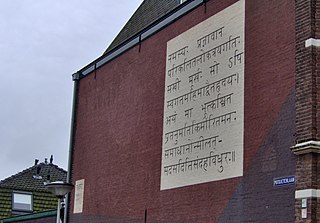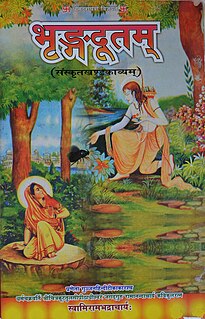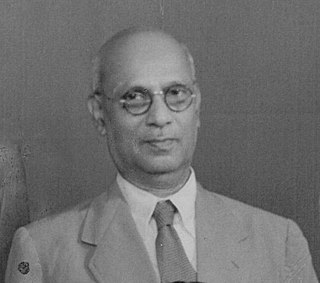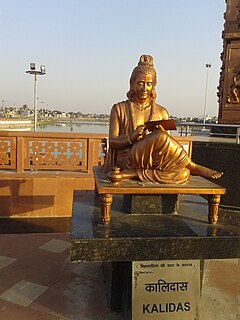The Prakrits are any of several Middle Indo-Aryan languages formerly used in India.
Malayalam literature comprises those literary texts written in Malayalam, a South-Dravidian language spoken in the Indian state of Kerala.

Gurram Jashuva was a Telugu poet.His real name was Anil Kumar.He was an IAS aspirant.He fell in love at tender age and became a poet.For that he was recognized with awards by Government of India. His literature's impact on the society was studied by researchers. Literary awards were instituted in his memory.
Paliath Achan or Paliyath Achan is the name given to the oldest male member of the Paliam family, a Nair Menon chieftain family from the Indian state of Kerala that figured prominently in the history of the region.
The term Indian classical drama refers to the tradition of dramatic literature and performance in ancient India. The origin of dramatic performance in Indian subcontinent can be traced back to as early as 200 BCE. Its drama is regarded as the highest achievement of Sanskrit literature. Buddhist philosopher Asvaghosa who composed Buddhacarita is considered to have been the first Sanskrit dramatist.

Shakuntala, also known as The Recognition of Shakuntala, The Sign of Shakuntala, and many other variants, is a Sanskrit play by the ancient Indian poet Kālidāsa, dramatizing the story of Shakuntala told in the epic Mahabharata. It is considered to be the best of Kālidāsa's works. Its exact date is uncertain, but Kālidāsa is often placed in the 4th century CE.

Sanskrit has been studied by Western scholars since the late 18th century. In the 19th century, the study of Sanskrit played a crucial role in the development of the field of comparative linguistics of the Indo-European languages. During the British Raj (1857-1947), Western scholars edited many Sanskrit texts which had survived in manuscript form. The study of Sanskrit grammar and philology remains important both in the field of Indology and of Indo-European studies.
Nationality words link to articles with information on the nation's poetry or literature.
Bhaṭṭikāvya, or "Bhatti's Poem", is a Sanskrit-language poem dating from the 7th century CE, in the formal genre of "great poem" (mahākāvya). It focuses on two deeply rooted Sanskrit traditions, the Ramayana and Panini's grammar, while incorporating numerous other traditions, in a rich mix of science and art, poetically retelling the adventures of Rama and a compendium of examples of grammar and rhetoric. As literature, it is often considered to stand comparison with the best of Sanskrit poetry.
Attoor Krishna Pisharody, ആറ്റൂര് ക്രഷ്ണപിഷരടി was born on 29 September 1875 to Vadakkedathu Narayanan Nambudiri and Pappikutti Pisharasyar in Attoor, a small village in Thrissur district, Kerala. He received primary education from his father. A maternal uncle, Bharata Pisharody initiated him into classical Sanskrit. Further education in vyākaraṇa, advanced kāvyas, etc. was provided by Meledathu Ramunni Nambiar. A paternal uncle Vengeri Vasudevan Nambudiri, invited him to live in his house and taught him nyāya, vyākaraṇa, and alaṃkāra. For some two years he assisted an aged uncle in managing a vedic school at Ceruvannur Sabhamatham. At the age of eighteen, Attoor unhappy with managerial responsibilities, left for Kodungallur Kovilakam with the twenty-five rupees that he had saved.
Hansa-Sandesha or "The message of the Swan" is a Sanskrit love poem written by Vedanta Desika in the 13th century AD. A short lyric poem of 110 verses, it describes how Rama, hero of the Ramayana epic, sends a message via a swan to his beloved wife, Sita, who has been abducted by the demon king Ravana. The poem belongs to the sandeśa kāvya, ‘messenger poem’, genre and is very closely modeled upon the Meghaduta of Kalidasa. It has particular significance for Srivaishnavites, whose god, Vishnu, it celebrates.

Madurā Vijayam, meaning "The Conquest of Madurai", is a 14th-century C.E Sanskrit poem written by the poet Gangadevi. It is also named Vira Kamparaya Charitham by the poet. It chronicles the life of Kumara Kampanna Udayar or Kumara Kampanna II, a prince of the Vijayanagara Empire and the second son of Bukka Raya I. The poem describes in detail, the invasion and conquest of the Madurai Sultanate by the Vijayanagara empire.

Akkitham Achuthan Namboothiri, popularly known as Akkitham, is an Indian poet and essayist of Malayalam language. Known for a simple and lucid style of writing, Akkitham is a recipient of several awards including Padma Shri, Ezhuthachan Award, the highest literary award of the Government of Kerala, Kendra Sahitya Akademi Award, Kerala Sahitya Akademi Award for Poetry, Odakkuzhal Award, Vallathol Award, Vayalar Award and Aasan Prize, besides many other honours.
Kristubhagavatam: A Mahakavya in Sanskrit based on the life of Jesus Christ is a Sanskrit on the life of Jesus Christ composed by P. C. Devassia (1906–2006), a Sanskrit scholar and poet from Kerala, India. For composing the Kristubhagavatam, Devassia won several awards, including the Sahitya Akademi Award for Sanskrit (1980). Composed in 1976 and first published in 1977, the poem consists of 33 cantos and over 1600 verses. It is said to have ornate and elaborate descriptions.

Bhṛṅgadūtam (2004), literally The bumblebee messenger, is a Sanskrit minor poem (Khaṇḍakāvya) of the Dūtakāvya (messenger-poem) genre composed by Jagadguru Rambhadracharya (1950–). The poem consists of 501 verses in the Mandakrāntā metre divided in two parts. Set in the context of the Kiṣkindhākāṇḍa of Rāmāyaṇa, the poem describes the message sent via a bumblebee by Rāma, spending the four months of the rainy season on the Pravarṣaṇa mountain in Kiṣkindhā, to Sītā, held captive by Rāvaṇa in Laṅkā.
Sanskrit Kavya literature has a long history of its development. The idea of sending of a message, through a messenger, from one person to another is not to be found wanting in the Hindu epics but it was taken up as an independent theme for a poem firstly by Ghatakarpara and later on by Kalidasa, Dhoyi, Udaya, Bhavabhuti and many other poets of note. Sandesha Kavya belongs to the category of Khandakavya.

Dr. L. A. Ravi Varma, was a historian and philosopher of the 20th century in Kerala, India. He was a critical figure who enriched the Ayurvedic literature contributing to its renaissance. In January 1940, he was appointed as Director of the joint Oriental Manuscripts Libraries of the Government of Kerala and the Kerala University. He was conferred the Honorary Title of Vaidyashastra Nipunan and Gaveshana Thillakan by Chithira Thirunal Maharaja, the King of Travancore, Kerala, India.








